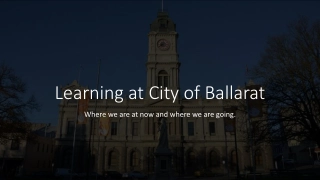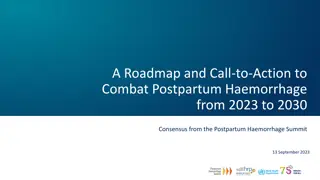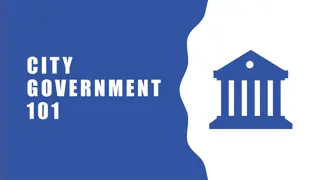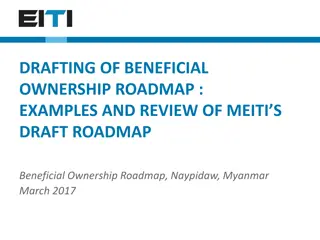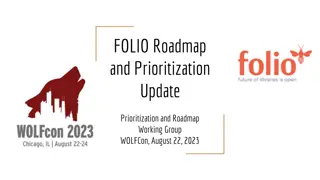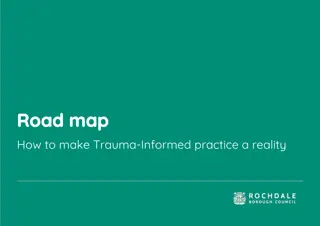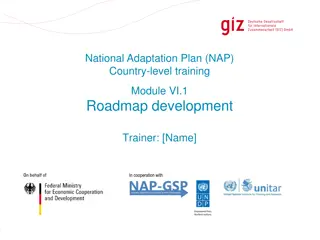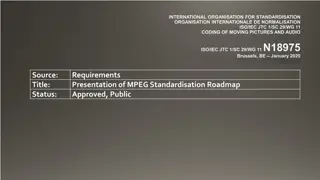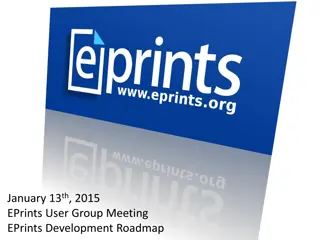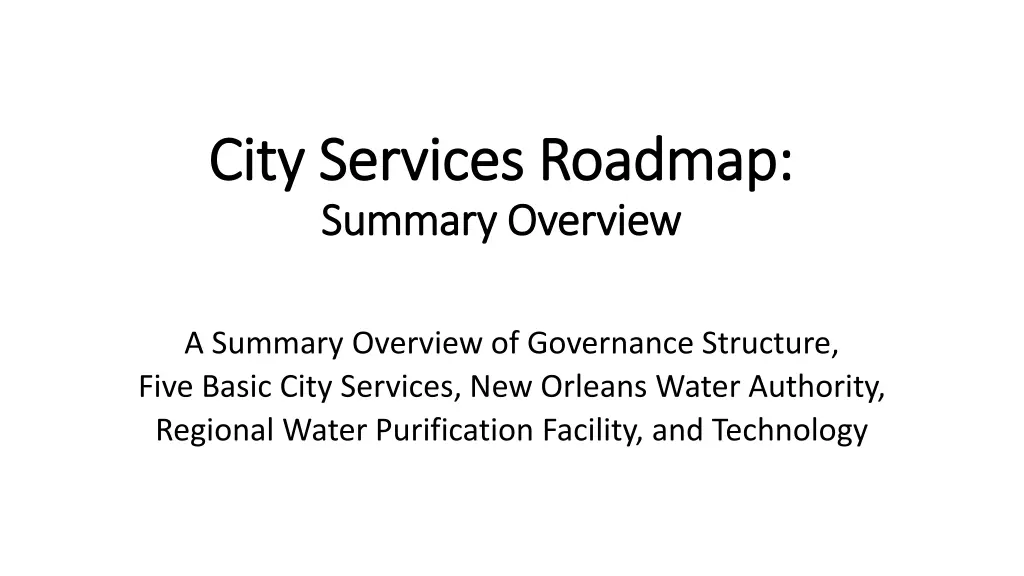
Enhancing Governance Structure for Effective City Services in New Orleans
Explore the proposed reforms to New Orleans' governance structure, focusing on making the Chief Administrative Officer (CAO) accountable, fostering collaboration among officials and organizations, and utilizing technology for efficient service delivery. Discover how increased transparency and compensation benchmarks can strengthen the CAO position for better city management.
Download Presentation

Please find below an Image/Link to download the presentation.
The content on the website is provided AS IS for your information and personal use only. It may not be sold, licensed, or shared on other websites without obtaining consent from the author. If you encounter any issues during the download, it is possible that the publisher has removed the file from their server.
You are allowed to download the files provided on this website for personal or commercial use, subject to the condition that they are used lawfully. All files are the property of their respective owners.
The content on the website is provided AS IS for your information and personal use only. It may not be sold, licensed, or shared on other websites without obtaining consent from the author.
E N D
Presentation Transcript
City Services Roadmap: City Services Roadmap: Summary Overview Summary Overview A Summary Overview of Governance Structure, Five Basic City Services, New Orleans Water Authority, Regional Water Purification Facility, and Technology
Introduction: Summary Overview | Objectives Section I. Governance Structure Section I Governance Structure presents an Organization Chart and describes Home Rule Charter (HRC) changes and the underlying rationale that supports recommended structural reforms. The Coalition s proposed reforms to CNO s Governance Structure serve the following objectives: Make the Chief Administrative Officer (CAO) responsible and accountable for the effective delivery of city services. Safeguard independent legal advice from the City Attorney and Law Department in representing their client, which is a corporate body the City of New Orleans (CNO). Foster coordination and collaboration among municipal and parochial officials (e.g., the District Attorney, the Sheriff, and Courts), Community-Based Organizations (CBOs), and other governmental entities in the region. Enhance the use of technology by empowering a Chief Information Officer (CIO) to coordinate systems in local government. Establish a Deputy Mayor for City Futures to plan and implement major economic development initiatives. Use training to instill a customer-friendly culture that incentivizes city employees to strive for excellence and that rewards them or holds them accountable based on data documenting their performance. 2
3 Introduction: Summary Overview | Organization Chart
Introduction: Summary Overview | CAO Section I. Governance Structure B. Chief Administrative Officer (CAO) Residents are deeply dissatisfied with the management of city government. In a December 2024 survey, 88% of respondents, both Black (82%) and White (92%), rated the management of city government negatively. Residents want change, but who s accountable for achieving it? The City Services Coalition recommends Home Rule Charter changes that will identify the Chief Administrative Officer (CAO) as the city official who is responsible and accountable for efficient delivery of city services. (See Coalition research and analysis in working papers on the CAO reforms in Appendix A.) We also recommend increased transparency: You can t hold someone accountable for what you cannot see. The proposed HRC changes will: (i) identify the CAO as responsible and accountable for effective delivery of city services; (ii) require the CAO to establish a data-gathering system and to post metrics-based performance evaluations on a public dashboard; (iii) delete the requirement of Mayoral approval if the CAO decides that it is necessary to remove a department head, but require the CAO to give written reasons for the removal. 4
5 Introduction: Summary Overview | CAO Section I. Governance Structure B. Chief Administrative Officer (CAO) (Continued) Increased compensation can strengthen the CAO position by attracting top-tier talent, whether local or national. The Coalition recommends that the CAO s compensation be benchmarked to national standards for top talent who have experience in managing an entity of comparable size, which may require adjusting salaries for other top talent in city government. The Coalition also recommends strengthening the CAO s capacity by creating three Deputy CAO positions, each responsible for identifying a limited set of priorities within their assigned subject area and taking the necessary steps to achieve alignment on those priorities with the Mayor and the Council: (A) The Chief Human Resources Officer will manage human resources functions for city departments. (B) The Chief Financial Officer (CFO) will be responsible for managing fiscal and revenue services for the city. (C) The Chief Information Officer (CIO) will be responsible for managing technology acquisition and services and for coordinating the needs of municipal and parochial offices. Shared IT systems, security protocols, and procurement processes will save money. Additional personnel will be required, but avoiding a security breach or a single ransomware attack would save millions of dollars. (See pages 195-202 for a detailed description of Tech/CIO.)
Introduction: Summary Overview | City Attorney Section I. Governance Structure C. City Attorney and Law Department The City should never settle for less than the best when receiving legal advice. We recommend an independent City Attorney and Law Department whose advice and counsel will consistently guide city personnel toward compliance with the law and diminish opportunities for corruption in local government. Current Home Rule Charter provisions direct the City Attorney and the Law Department to represent a corporate body, the City of New Orleans (CNO). The Home Rule Charter (HRC) should be amended to include an explicit requirement that the City Attorney and lawyers in the Law Department must adhere to the Rules of Professional Conduct governing lawyers who represent a corporate body. Voters approved a significant amendment by adding HRC Sec. 4-106(4) to require Council confirmation of department heads, including the City Attorney. The City Council should use its confirmation hearings to establish a clear understanding that the City Attorney and Law Department owe duties of loyalty to CNO, the corporate body. (See Appendix B for research regarding the professional obligations of counsel for a corporate body.) 6
7 Introduction: Summary Overview Section II. Five Basic City Services Section II Five Basic City Services takes a deep dive into each of five color-coded service areas. This Introduction summarizes Sections A-E, which contain the Coalition s recommendations for each service area and the underlying reasons that supported those recommendations. The Synopsis & Strategies pages that begin each Section give a good summary of the principal recommendations and reasons supporting them. Readers can then review Background and Data and Best Practices for in-depth information about each of these Five Basic City Services: A. Streets & Infrastructure Maintenance B. Drainage & Water Management C. Permitting D. Public Safety & Justice E. Trash & Clean Public Spaces
A. Streets & Infrastructure Maintenance B. Synopsis & Strategies for Success Improved Communications: The city s infrastructure agencies (DPW, SWBNO, and others) speak to two external audiences the Public and Contractors. Each has its own interests and needs its own tools. The Public needs communication about traffic flow disruptions due to street closures and maintenance projects. Currently, RoadWork NOLA does not provide timely information. The Solution: A user-friendly dashboard that shows all infrastructure projects and is regularly updated with information about project status, expected completion date, and an interactive map revealing which areas are prioritized for repairs based on population density, historical neglect, or proximity to essential services such as schools and hospitals. See as a Best Practice the NYC Capital Projects Dashboard at page ___. The Public needs proactive outreach from city agencies communicating real-time information about current or upcoming traffic disruptions. The Solution: Send email and text alerts to schools, hospitals, and major employers so they all can in turn notify their constituencies. See as a Best Practice DC 311 (page ___), which enables interaction between a 24/7 call center and residents via email, texts, an app, online service requests, and X (formerly Twitter). Contractors need information about opportunities to bid on infrastructure projects. The Solution: Centralize procurements in an Office of Procurement and establish a procurement forecasting log that gives contractors advance notice on upcoming contracting opportunities, encouraging more contractor competition and fostering more equitable distribution of contracts. 8
A. Streets & Infrastructure Maintenance B. Synopsis & Strategies for Success Improved Management and Use of Technology Contractors need reliable processing of invoices and better management of their contracts and change orders. Problems with the Timeliness of Vendor Payments (LA Legislative Auditor 2024) explains why some potential bidders choose not to bid, which limits competition and undermines the quality of proposals the city receives. The Solution: The Business Resource and Administrative Support System (BRASS) can streamline and modernize the city s cumbersome processes, but is challenged by legacy systems and by inadequate acceptance among employees, who need better training and support in using BRASS. Technology personnel need to integrate Quick Base, Procore, and invoicing systems and then assist staff in understanding and using BRASS. Personnel Problems Delayed Street Repair: Projects languish for lack of focused leadership and support. The Solution: Dedicated project managers in the Project Delivery Unit (PDU) must devote consistent attention to projects from start to finish. Civil Service: DPW, S&WB, and other infrastructure agencies say that civil service guidelines limit their ability to hire skilled project managers. The Solution: In the short run, work with Civil Service to align job skills and higher pay with national norms, making project management positions more marketable. Beyond these tweaks within the existing system, place Human Resources under a Deputy CAO for HR or return HR responsibilities to the departments. 9
A. Streets & Infrastructure Maintenance B. Synopsis & Strategies for Success Coordination and Collaboration: This Cross-Cutting Theme shows up repeatedly and as a consequence, problems show up in multiple city agencies when coordination is lacking. Here, we encounter the Coalition s first coordinating entity, a Capital Cabinet established to avoid disruptive and repetitive construction projects. The Problem: Everyone in New Orleans has experienced the phenomenon streets torn up and repaired over weeks or months, followed soon after by another protracted construction project on the same streets. The Solution: A Capital Cabinet chaired by the CAO will bring all infrastructure agencies and stakeholders together for improved planning and coordination of projects. A short-term model was deployed with success when public and private sector personnel convened in regular meetings to coordinate preparations during the months-long run- up to Super Bowl LIX in February 2025. The Capital Cabinet will institutionalize coordination and collaboration by stakeholders as an ongoing feature in the infrastructure process. 10
B. Drainage & Water Management Synopsis & Strategies for Success New Orleans Drainage and Water Management challenges are existential: the sea is rising; the city is sinking; S&WB pumping capacity cannot stem the tide of floodwaters that regularly inundate neighborhoods. Saltwater intrusion threatens water quality annually, and boil water advisories are all too frequent. Finances to fix these problems remain insufficient, and a complex governance structure obscures accountability for these shortfalls. Public trust is at its nadir. The Coalition recommends increased coordination and collaboration to address myriad problems in drainage and water management. Act 783 of 2024 (approved unanimously by the House and Senate) mandates remedies that are in keeping with this strategy: The S&WB will enter into a Cooperative Endeavor Agreement (CEA) with the City and the Coastal Protection and Restoration Authority (CPRA) to expedite expenditure of $141.3 million to improve surface water storage. The S&WB will sign a CEA with the Louisiana Department of Transportation and Development (LaDOTD) to manage capital projects over $100 million. S&WB and LaDODT will prepare and update a capital improvement plan encompassing maintenance and a cost- benefit analysis of future projects. S&WB will develop, along with several governmental entities in the region, a multi-agency urban flood prevention planto meet the southeast region s needs for proper drainage, to model and predict storm damage, and to plan for emergency response priorities. 11
B. Drainage & Water Management Synopsis & Strategies for Success The Coalition supports these initiatives and recommends an additional one that builds upon the foregoing multi-agency collaboration among the S&WB, CNO, and Public Works Departments in Jefferson, Plaquemines, and St. Bernard Parishes. A Regional Water Purification Facility built upon land that the S&WB already owns would be sufficiently far upriver to eliminate the threat of saltwater intrusion (page __). All four parishes would benefit from reduced costs in supplying water to their residents as an outgrowth of this consolidated response. The S&WB s billing problems that generated considerable public animosity will be diminished by the installation of smart meter technology, but unresolved bill disputes have continued to be a source of frustration. In August 2024 the Council authorized Hammerman & Gainer, LLC to resolve the backlog of disputed bills via arbitration. The Coalition recommends that S&WB consider addition of a small claims mediation program that might resolve modest amounts without incurring the costs of an arbitration. S&WB Reorganization and Reform: Voters responses in a December 2024 public opinion survey spoke forcefully in support of major reform at the S&WB (80%); an additional 15% favored minor changes ; only 2% said no change was needed. The Coalition agrees that major changes are needed now. The Coalition recommends a New Orleans Water Authority (NOWA) to replace the S&WB. 12
B. Drainage & Water Management Synopsis & Strategies for Success New Orleans Water Authority: The Coalition s recommendation is informed by the experience of our two ex-Mayor advisers, Tom Murphy and Anthony Williams, who oversaw the successful conversion of their water systems in Pittsburgh, PA, and Washington, D.C., into independent water authorities. The NOWA conversion will take place under supervision of a Water Authority Transition Committee with a minimum one-year lifespan. Full implementation would require City Council approval. The NOWA Transition Committee will consist of members appointed by the Mayor, City Councilmembers At-Large, the Governor, and the Orleans House and Senate legislative delegations, as well as management and engineering professionals. The NOWA Transition Committee will determine: A legal, legislative, and administrative implementation plan for the changes; A merit system of hiring and firing by a Human Resources department in NOWA; A formula rate plan administered by the City Council or the Louisiana Public Service Commission; A fair and equitable stormwater management fee to replace property tax millages that are currently dedicated to drainage; and A new Customer Ombudsman to receive and act upon complaints. The Transition Committee will become NOWA s permanent Management Board when the transition period expires. 13
C. Permitting Synopsis & Strategies for Success The Department of Safety and Permits has been well studied by Matrix Consulting Group [LINK] and by the Office of Inspector General [LINK]. The Coalition s recommendations are informed by their work. We agree with these recommendations to improve departmental operations: Streamline the application process to eliminate unnecessary tasks. Assure completeness of the application before it is filed. Create a task force of departmental personnel and developers to identify choke points in the permitting process and devise solutions. Assign a single staff personto oversee a permit s progress through the process from start to finish. Establish an online real-time permit tracking tool that enables applicants to apply online and follow their permit through the process, which will save time for applicants and staff by reducing follow-up inquiries. Develop a detailed checklist and mandate its use for every inspection. Regularly audit inspections and checklists for compliance by in-house and third-party inspectors. Several of these recommendations resonate with Cross-Cutting Themes that the Coalition has identified. 14
C. Permitting: Synopsis & Strategies Coordination and Collaboration: The task force enables structured collaboration between public and private sector stakeholders. Assignment of a single person to serve as a concierge for permit applicants will provide coordination among the multiple city offices involved in permit reviews. Transparency: The online tracking tool will serve transparency and build public trust in the permitting process.But contracting services out to third party inspectors can create problems with transparency; the department must address this problem by writing transparency requirements into those same contracts. Technology: By moving services online, technology will ease the burdens on staff and applicants. But staff need training and compliance monitoring to use the available technology for example, LAMA, where inspectors frequently fail to upload the required documentation. Noncompliance causes delay and worse, sometimes facilitates and conceals corruption. Technology can assist in monitoring compliance. Personnel Problems: Noncompliance speaks ultimately to personnel, which in turns raises questions about civil service as an obstacle to agency performance. The department needs greater control over human resources to develop recruitment and retention policies, align compensation with marketplace norms, and respond to high employee turnover and vacancy rates with an expedited hiring process. These needs lend additional weight to recommended reforms in civil service (page __). Implementation should be informed by Best Practices such as Riverside, California s One Stop Shop (page __) and New York City s City of Yes program (page __). 15
D. Public Safety & Justice: Synopsis and Strategies These recommendations to improve benefits and facilities must be accompanied by fully-informed labor negotiations. The city should undertake data-driven peer benchmarking and budgetary projections in advance of collective bargaining sessions. Reducing Jail Population: New Orleans steadily increasing jail population (2022: 967, 2023: 1120, 2024: 1448 well beyond the City Council s maximum of 1250) owes much to inadequate use of assessment risk tools. When administered the Public Safety Assessment (PSA), nearly 60% among those being held on violent charges in the Orleans jail rated risk levels of 1 or 2 the lowest ratings for risk, but nonetheless still behind bars. In 2023, 22% of the jail population did not even receive a PSA assessment. New Orleans might take instruction from neighboring Jefferson Parush and its Code 6 program (page152), which has an automatic triage system. Bail policies also play a role in jail overcrowding. The City Council s approval of a Municipal Bail Ordinance in 2017 made desirable changes. It s time for a further bail reform to include minor felony offenses, and the new Mayor in 2026 should propose an appropriate amendment to the City Council. Civilianizing NOPD Activities: Every law enforcement function transferred to a civilian means one more police officer on the streets. Both Baltimore (page 162) and Houston (page 163) have had exemplary success in transitioning former police jobs into a civilian workforce notably, crime lab, fleet maintenance, and records management functions. The Coalition recommends a similar approach in New Orleans. 16
D. Public Safety & Justice: Synopsis and Strategies The Coalition s recommendations for public safety and justice reforms fall into four silos: Coordination and Collaboration NOPD Working Conditions Reducing Jail Population Civilianizing NOPD Activities Coordination and Collaboration: Parochial and municipal officials, such as the DA and NOPD, work together with Judges in the state court system toward a shared goal: a well-administered criminal justice system. But they do not always work together in pursuit of that goal. Coordinationis an essential element In the Coalition s plan for public safety and justice reforms. The Public Safety and Justice Council will be central in fostering collaboration among public sector officials and private sector stakeholders (e.g., nonprofits and community-based organizations). The Council could be guided by Best Practice in Montgomery County, Maryland (page 159). The Council must set clear mandates for the NOPD to produce quicker lab results and for the courts to accelerate processing times. The Council should also take responsibility for coordinating efforts to divert appropriate individuals from incarceration into treatment by law enforcement and mental health services such as the Law Enforcement Assisted Diversion (LEAD) program and Mobile Crisis Intervention Unit (MCIU) (page 153). NOPD officers need mandatory training sessions about the proper use of these jail diversion resources. 17
D. Public Safety & Justice: Synopsis and Strategies New Orleans crime lab has struggled with accreditation and a large backlog of untested rape kits. Its distressing 6.75% clearance rate on rape cases falls far short of even the disappointing national averages of 33-38% and is near the bottom of comparably-sized cities in the clearance of rapes. The crime lab is a prime prospect for civilianization. Houston s Crime Lab has become its Forensic Science Center, a change in more than name only since the newly independent entity is populated with subject matter experts who focus on purely forensic tasks. The Center no longer has a conflict of interest where its results might be influenced by investigative pressures from law enforcement. The members of its Board of Directors are a diverse group of professionals from the public sector, community organizations, health care centers, and academic institutions. New Orleans should follow Houston s lead. New Orleans 360 is modeled after the successful Omaha 360 program that engages local CBOs to ameliorate the ill effects of crime and poverty in neighborhoods. Omaha s 360 Violence intervention and Prevention Model is a community-based approach to reduce gun violence by direct intervention and addressing root causes. Its nationally recognized strategy focuses on community engagement to build stronger police-community relationships. Its core components are collaboration, prevention, intervention, enforcement, reentry, support services, and sustainability. The New Orleans Data-Informed Community Engagement (NODICE) system currently operates in two under- resourced neighborhoods. NODICE relies on data-driven, equitable decision-making with a focus on public safety, quality of life, and economic development to direct resources toward areas of greatest need. 18
D. Public Safety & Justice: Synopsis and Strategies Coordination in the realm of technology is also important. The Coalition has recommended that the City s Chief Information Officer (CIO) be responsible for integration and functionality of computer systems across municipal and parochial agencies (page __). NOPD Working Conditions: For more than a decade, New Orleans has suffered grievous declines in the number of police officers for example, a 24% reduction in force from 1200 officers in 2018 to 917 in 2023. Since 2021, the NOPD has been losing more officers than it gets in new hires. Correspondingly, NOPD response times grew from an average of 80 minutes during 2014-2020 to 146 and 130 minutes in 2022 and 2023. The Coalition recommends improving retention of officers by improving their working conditions, ranging from improvements in the troubled physical infrastructure where officers work and extending to improved benefits on the job. When asked in a survey, officers identified their four top desired benefits as: 2% longevity pay, annual step increases, equipment upgrades, and sick pay days paid one for one-for-one at retirement, all seemingly appropriate and achievable. In addition, the department could transform costs that officers typically pay out-of-pocket and get reimbursed into direct benefits provided by the department, such as uniform allowances. Prioritizing capital and janitorial maintenance is also crucially related to improving working conditions and facility upkeep. Broken air conditioning, sealed windows that prevent proper ventilation, and infestations of rats and roaches degrade morale. The NOPD should also increase the inventory of essential supplies and streamline internal supply management processes to keep stations in good working order. 19
E. Trash & Clean Public Spaces Synopsis & Strategies for Success The Department of Sanitation manages challenges in four discrete areas: Trash Pick-Up Employee Recruitment and Retention Illegal Dumping and Litter Enforcement Trash Pick-Up: Contractors labor shortages during the pandemic caused unreliability in trash pick-ups. Complaints about missed or delayed collections averaged 1446 monthly in 2022. Residents were also angered by reductions in service from twice to once a week while paying the same amount in sanitation fees. The City and its contractors responded to the problem of unreliable pick-ups by modernizing equipment (including trucks with GPS tracking technology) and by a fairer revenue stream to help contractors stabilize their workforce. Complaints about pick-ups declined in 2024 to an average of 636 per month a reduction in improved reliability in collection services of nearly 56%. The City could do even more to respond to residents frustrations. The Coalition recommends creating a dashboard that gives the public real-time updates on disruptions in scheduled collection services. Sanitation should also use texts, emails, and website updates to reach out actively to residents. 20
E. Trash & Clean Public Spaces Synopsis & Strategies for Success Finances continue to be a problem, with a projected $24 million deficit in 2024 between revenues generated by sanitation fees and the actual cost of collection a deficit that must be covered from the City s general fund. Employee Recruitment and Retention: The Coalition recommends that Sanitation develop a recruitment and retention strategy, using as its model a Best Practice : the One Clean Houston initiative (page 180). Sanitation s recruitment and retention plan could include hiring bonuses, improved compensation and benefits, and pathways for career advancement. The department may work within current civil service constraints to accomplish these goals or might in the future benefit from the Coalition s recommended civil service reforms (page ___). Illegal Dumping and Litter: Successfully overcoming the blight of illegal dumping and litter requires a multi-front strategy that includes data gathering, community engagement, and public education. Dallas adopted a data-driven approachto identify waste hot spots (page 179), then deployed code enforcement officers and clean-up crews to targeted areas. Using predictive data analytics, Dallas installed cameras to deter illegal dumping and to capture video evidence for use in enforcing the law against violators. New Orleans should do the same and should create an online reporting tool so that residents can easily report illegal dumping. A Best Practice, San Rafael, CA, used mini-grants as incentives for businesses and property owners located near chronic dump sites to partner with the city in installing nighttime lighting, surveillance cameras, and barriers (page 181). These measures discouraged dumping and fosteedr a sense of shared responsibility among residents. 21
E. Trash & Clean Public Spaces Synopsis & Strategies for Success Insufficient public education may partially explain why some people engage in illegal dumping because they re not aware of alternatives, such as recycling, bulk item pickups, and drop-off sites. The Coalition recommends a multi- lingual public information campaign using social media, radio, and local TV to raise awareness about the ill effects of illegal dumping, educate the community about alternatives, and foster personal responsibility. Community cleanup events give residents an opportunity to participate directly in cleaning up litter. Fort Worth, TX, launched its anti-litter campaign (page 178) with a litter survey followed by public engagement with community cleanup events. A 2017 study by Texans for Clean Water found cities spending less on public education and community outreach paid more in abatement costs a powerful message about responsible stewardship. Enforcement: As with many service delivery problems, better coordination is the key to better enforcement. One Clean Houston (page 174) assigned specific responsibilities to its Department of Neighborhoods, Solid Waste Management, and the Police Department, giving each agency a defined role in dealing with illegal dumping. The 311 system was trained to Littering and Illegal Trash Dumping route complaints directly to the appropriate agency. Regular interagency meetings assured ongoing coordination. New Orleans can model this Best Practice to coordinate responsibilities among Sanitation, the NOPD, and Code Enforcement. Houston also established a specialized code enforcement team to deal with heavy trash in the public right-of-way (page 176). New Orleans should establish a similar team of code enforcement personnel dedicated to enforcement actions against illegal dumping pursuant to the administrative adjudication procedures authorized by R.S. 13:2575. 22
New Orleans Water Authority The Coalition recommends replacing the current Sewerage & Water Board structure with a new entity called the New Orleans Water Authority (NOWA) that would handle all matters related to drainage, pumps, pipes, water quality, sewerage, and disposal. To transition from the current S&WB model to the new NOWA model, we recommend creation of a Water Authority Transition Committee, with a maximum one-year lifespan, to oversee the changeover. Full implementation would be made during this period and would require City Council approval. The NOWA Transition Committee would have representatives appointed by the Mayor, City Council-at-Large members, the Governor, the New Orleans state legislative delegation, as well as management and engineering professionals who could be selected in accordance with statutory requirements similar to those governing the Southeast Louisiana Flood Protection Authorities (R.S. 33:330.1). The Committee would elect its own chair and appoint NOWA s top leadership team a Director, Chief Operating Officer, and Chief Engineer. Once the transition period expires, the Transition Committee would become the NOWA Management Board and oversee the agency on a permanent basis. The director of NOWA will be part of a new Capital Cabinet proposed by the Coalition to coordinate all New Orleans infrastructure needs with every part of city government (Streets, etc.) and all public utilities (Entergy, Cox, etc.). It would also coordinate with federal state, and regional authorities, as needed. 23
24 New Orleans Water Authority The NOWA Transition Committee would determine: How proposed changes can be implemented legally, legislatively, and administratively, and whether changes to the Louisiana Constitution or the New Orleans Home Rule Charter are required. We believe that, to the extent possible, recommended changes must be combined into a coherent package that the people of our city can evaluate as a whole. While NOWA should be structured as a public agency under city control, we recommend that the NOWA Transition Committee (and its successor NOWA Management Board) should consider the option of contracting out certain services. This option should only be considered if it will (a) save money for New Orleans residents and businesses, (b) safeguard and sustain a high quality of management and customer service, (c) provide maximum protection for the city and its people, and (d) be implemented pursuant to full transparency, strong oversight, and public engagement. While the Coalition sees contracting out services as a possible option, the Coalition is not recommending privatizing NOWA (i.e., selling its assets to a private company for profit). For public functions and operations that would remain part of the NOWA governmental structure, the Transition Committee would determine:
New Orleans Water Authority How a Human Resources department can be created for NOWA that would operate outside of the existing civil service bureaucracy, which in many ways has become an impediment to streamlined management. The Transition Committee would establish NOWA s own merit hiring and firing process that would guard against political hiring and firing. This approach would give NOWA s leadership flexibility, authority, and responsibility for efficient human resource management and personnel administration. Existing employees of the S&WB would be able to reapply for their current or modified positions. How water rates will be set using a formula rate plan wherein all operating costs (personnel, materials, equipment, improvements, pensions, debt service, etc.) are totaled and submitted to a designated entity (such as the New Orleans City Council or the Louisiana Public Service Commission) that would be responsible for determining a fair and equitable rate for the customer base. How to institute a fair and equitable stormwater management fee to replace current property tax millages that are now dedicated to drainage. How a new Customer Ombudsman should be structured so that city residents and businesses can easily contact NOWA with service complaints and expect helpful, immediate responses. How transparency, technology, management, employee training, contractual safeguards, and purchasing can be accomplished according to best practice standards. Big change only works when it s handled competently and efficiently. The Coalition believes that it s now time to take action to create a new model with streamlined management, sensible structure, and full public transparency. 25
26 Regional Water Purification Facility Safe drinking water for New Orleans and surrounding parishes is periodically challenged by saltwater intrusion. The Coalition recommends a Regional Water Purification Facility and proposes an east bank site that is located 12 miles upriver in St. Charles Parish, that is already owned by the City, and that will not be affected by saltwater intrusion. A collaboration among Jefferson, Orleans, Plaquemines, and St. Bernard Parishes would offer safe drinking water for their residents, free them from the threat of saltwater intrusion, and afford economies of scale by consolidating water purification services. New Orleans voters overwhelmingly support regionalizing water purification by 88%. The facility could be implemented through the following strategies: State legislation creating a political subdivision; or Cooperative endeavor agreements establishing an intergovernmental compact among the participating parishes and municipalities.
III. Cross-Cutting Themes The Cross-Cutting Themes described in Section III will improve delivery across a broad range of city services, if properly deployed. A. Technology | Background Starting in the early 2000s with the Nagin administration, the City began having Chief Information Officers (CIO). This was in line with the general business climate change that started to see Computers writ large as less of a technician role and more as a participant in facilitating the business functions of organizations. A senior executive with the experience necessary to lead Information Technology and interface with multiple departments with different missions is beyond the cost and organizational capabilities of most City-aligned agencies, which is why we have a City CIO but not a Criminal Court CIO or a Parks & Parkways CIO. Of all of the municipal agencies, the City of New Orleans has the budget and internal expertise to run its own data center or cloud infrastructure. In the past under Sherriff Foti, this kind of expertise and budget existed in-house, but for the last 20+ years that has not been the case (which is why we had no successor to DocketMaster until the recent Justice Modernization Project). These circumstances highlight a major issue the fracturing of Information Technology operations into multiple factions. Everyone wants their own data and their own operations. This may seem to serve the short-term interests of individual politicians and their public offices, but it is not in the interest of those same offices long-term not is it in the interests of the public at-large. 27
28 Cross-Cutting Themes| Technology A. Technology | Concerns Going Forward Whether it involves migrating municipal information to the Cloud, deploying Artificial Intelligence (AI) in public functions, or hardening public assets from a Cyber-security standpoint, our publicly-owned Information Technology operations have never needed high-level leadership more. With next year s transition from one administration to the next, our community must address this issue from both a budgetary and an organizational standpoint. Various governmental offices in Orleans Parish, from the Recorder of Mortgages to the Sherriff, are exposed to budgetary, security, and operational risk from short-term fixes as well as the lack of long-term vision and budget. We also have many zombie systems in various places in municipal government that were almost turned off when they were replaced. Each of these can be retired if the CIO is empowered to help in doing so. For example, if we were to replace the system for tracking recorded mortgages or sales of homes, we might expect that the Clerk s office would coordinate with the City s IT group to figure out how to address best practices, security concerns, and operational needs. After all, the City s IT office has significantly more resources than the Clerk does. But this would only happen if the Clerk or someone in their office happened to think about leveraging City IT to help them in the transition. Additionally, a City CIO might only help if they affirmatively decided to get involved; there is no formal expectation that the City s CIO is the go-to person or group for these things. Sometimes this type of coordination and sharing of practices occurs, but just as often it does not. We could play that scenario out for any of the systems used by a City-aligned agency. Consider the boondoggle that the Hexagon project ended up being for everyone involved, which was with the Orleans Parish Communications District that is closely aligned with City IT because they share Criminal Justice data. In that instance, millions of dollars were literally wasted and large amounts of time.
Cross-Cutting Themes | Technology A. Technology | How to Address the Issue The solution is to structure the role of the next Chief Information Officer of the City of New Orleans differently from its current structure. This role should be not just for City-operated systems and networks but should be a center-node for all of the agencies that operate with public money. This approach would allow for shared IT resources such as Cloud Infrastructure and systems capacity. It would allow for a shared Chief Security Officer (CSO) who would provide guidance and rule how systems across public agencies are required to secure data. It would alow for greater expertise in IT to be present for RFP writing, issuance, and award for systems across all agencies. Obviously, this approach would require more budget for personnel in the CIO s office. You can t do what is discussed in this document with the existing Org Chart in the CIO s office. Discussions with the current CIO indicated approximately 15 people would be needed that do not currently exist in the budget a cost of about $2 million. Importantly, other elected officials must not see this office as a challenge to their legal responsibilities. The agencies need to continue to own the systems in terms of responsibility, requirements, and security authorizations governing who can receive data from them. But the City s CIO should be the center-node for all infrastructure and play an advise-and- consent role for new systems to be brought on-line. 29
30 Cross-Cutting Themes | Technology A. Technology | What would the payback be for these changes? The first and most important benefit from changing the CIO s role is not money but efficiency, which ultimately saves money. A cross-organizational CIO could seek solutions that would benefit every stakeholder agency. For example, centralized security functions (such as edge-security devices and intrusion detection systems) could be more easily rolled out to all agencies in this model. Avoiding a single breach of security or ransomware attack would save millions The scale of IT infrastructure means that new systems added to the existing Azure Cloud and existing City data center will cost incrementally more. But the base of this infrastructure is already paid for. The concept is similar to the way we can fly many airlines and lots of different planes off the same runway and tower system at the airport. The largest saving is early involvement of senior Information Technology leaders in the process of replacing systems. A CIO and senior technical people may not be regarded as knowledgeable about how an agency runs, but they will have implemented many systems over their careers. The particulars of an agency s business model may not be native to them, but questions about picking replacement systems have more to do with knowledge of IT than knowledge of a business. At the state-level we see this in the way bids for new systems are handled: the agencies own the procurement, but the technical parts are judged and usually written by or in coordination with the State CIO s office.
Cross-Cutting Themes |Technology A. Technology | How can Agencies outside of City Government own the outcomes in this model? An issue that comes to the forefront from the preceding section is, How can an Agency like the District Attorney or the Mosquito, Termite & Rodent Control Board (to name two very different examples) have ownership of outcomes if they don t own the infrastructure their systems run on and have to consult the CIOs office to make IT purchases for their agency? Additionally, How can we avoid perverse incentives that make the CIO s office the City of NO, where ideas and new initiatives go to die? Key here is how the CIO s office and the City s technology infrastructure are involved. What are the rules of engagement? What is the CIO s office responsible for, and maybe more importantly, what is it not responsible for? Setting security practices and policies and running broad-based software like Active Directory, Data Warehouses, Intrusion Detection, and Antivirus should belong to a centralized IT group. Likewise, provisioning and overseeing server-level instances of software as well as externally-facing APIs and such also fall squarely in the purview of this office. But determining how many instances an agency needs or what runs on them probably isn t. Having been at the mercy, on occasion, of the State Data Center when working on State projects, we know firsthand that strong Service Level Agreements are critical to keeping the CIO s office honest and incentivizing them to say Yes as often as practical to new software and new ideas. It s easy to say Yes to an AI system that would read 311 tickets and link related ones to each other. But because that AI would have to read the whole 311system and probably other system data to do its job, this feature is a potential security risk. Thus, we often get a no instead of the needed yes because it s risky for a tech person to say yes to a system that s newly developed and may not yet be well understood by the tech person. We will need to incentivize and celebrate innovation in the CIO s office and defend them from cheap attacks while simultaneously holding them accountable. 31
32 Cross-Cutting Themes | Technology A. Technology | How can Agencies outside of the City Government itself own the outcomes in this model? The suggested solution to this issue, based on conversations with the current CIO, is to create an IT Advisory Board to help the new CIO and Mayor craft these policies, give the CIO a group of technical leaders to bring new ideas into play, and allow the publicto have a voice in some of these discussions. Obviously, this advisory board would have to be just that advisory. The CIO should report to the CAO and does not need a new boss. How that advisory board would function is beyond the scope of this short write-up but there are similar advisory boards in other cities that we can learn from, then take from them what is good and works well for us. A. Technology | What does this cost? How long does it take? The age-old questions in every IT endeavor are How long? and How much? The good news is that the infrastructure to be leveraged already exists, and the City pays for it already. Incremental costs per system are the primary driver for additional expenditures but will be much less than the actual cost of any new system for almost any department we ve seen. To use the airport analogy, one new gate doesn t drive costs at the airport since you have already built the terminal and many other gates. In terms of timing, the goal would be to move systems that can easily be moved to the existing infrastructure. These should be outlined in a project to identify all of the systems that exist and to take a census of what they require, when they should be updated or changed, and so forth.
Cross-Cutting Themes | Technology A. Technology | What does this cost? How long does it take? All new systems should start with the assumption that they are going to be on the shared infrastructure and costs, and SLAs should be negotiated for those as part of their procurement process. A standard MOU will need to be crafted that outlines the relation between the City CIO and the other agencies so that this process can be expedited going forward. The 15 staffers that the current CIO thought would be needed adds approximately $2 million per year in payroll and related expenses based on the CIO office s current pay rates. Costs beyond that will require more details as to everyone s intended roles and responsibilities in order to estimate costs. A. Technology | What is the Roadmap or Order of Operations? What step goes first if the City decides to implement this plan? Any plan s success hinges on how it is implemented. Execution can make up for bad planning to some degree, but bad execution will destroy even the best plans. Below is a proposed order in which the elements discussed above should be implemented. 1.Advisory Panel a. Create advisory panel determine expectations and feedback mechanisms b. Work with CIO to determine metrics and costs for how the City s Azure platform can be scaled out for other agencies. c. Ongoing: i. Budget support for CIO ii. Updates re: technology landscape 33
34 Cross-Cutting Themes | Technology A. Technology | What is the Roadmap or Order of Operations? What step goes first if the City decides to implement this plan? The Advisory Panel should be created first because these individuals will help provide comfort to other agencies and the City Council. It s also the first step because the second and third steps rely on many assumptions being fleshed out by the panel. 2. Central IT Strategy and Funding a. Secure commitment by all appropriate agencies b. Define relationship between City s Azure platform and owned systems of other Agencies c. Thoroughly re-examine existing reporting systems (Microsoft Power BI) and its suitability to the broader needs; secure commitment by all stakeholders This second step in our Roadmap involves the specifics of implementationsand should be informed by discussions with the agencies regarding their needs and with the Advisory Panel regarding other organizations experiences. 3. Procurements a. Devise pre-clearance system for IT vendors similar to state contracting in Louisiana and elsewhere, enabling purchases via Task Order rather than RFP b. Re-compete every two years The State did a similar staff augmentation contract and has done several hardware and software agreements. The City is not nearly as large a purchaser as the State, but this system still should be viable and will make it easier to implement the overall project.


